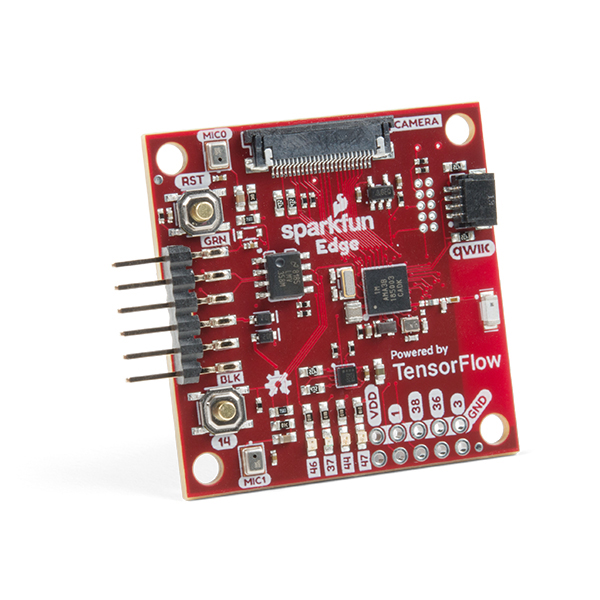Edge computing is here! You've probably heard of this latest entry to the long lineage of tech buzzwords like "IoT," "LoRa," and "cloud" before it, but what is the edge and why does it matter? To give context for the edge realize that the first computers were very large centralized machines and slowly that technology reached people in their own homes with the personal computer. Well history repeats itself and the cloud began with large, remote, and inaccessible computers. Edge computing is the ability to perform cloud computing tasks at the "edge" of the cloud - that's you!
SparkFun's Edge board is based around the newest edge technology and is perfect for getting your feet wet with voice, gesture, and even image recognition without relying on the distant services of other companies. The magic sauce is in the utilization of Ambiq Micro's latest Apollo3 Blue microcontroller whose ultra efficient ARM Cortex-M4F 48 MHz processor can run TensorFlow Lite using only 6 uA/MHz. Apollo3 Blue sports all the cutting edge features expected of modern microcontrollers including 6 configurable I2C/SPI masters, 2 UARTs, 1 I2C/SPI slave, a 15-channel 14-bit ADC, and a dedicated Bluetooth processor that supports BLE5. On top of all that the Apollo3 Blue has 1 MB of flash and 384 KB of SRAM memory - plenty for the vast majority of applications.
On the Edge you'll have built-in access to sensors, Bluetooth, I2C expansion, and GPIO inputs/outputs. To support edge computing cases like voice, gesture, and image recognition the Edge board features 2 MEMS microphones with an amplifier, an ST LIS2DH12 3-axis accelerometer on its own I2C bus, and a connector to interface to an OV7670 camera (sold separately). An onboard Bluetooth antenna gives the Edge out-of-the-box connectivity. Also available on the board is a Qwiic connector to add I2C sensors/devices, four LEDs, and four GPIO pins. To boost the low-power capabilities of the board we've outfitted it with battery operation from the CR2032 coin cell holder. Programming the board is taken care of with an external USB-serial adapter like the Serial Basic Breakout.
- /Documentation - Data sheets, additional product information
- /Hardware - Eagle design files (.brd, .sch)
- /Production - Production panel files (.brd)
- Board Support Package (BSP) - Ambiq SDK Board Support Package for the SparkFun Edge.
- Edge Board Hookup Guide - Basic hookup guide for the SparkFun Edge.
- Software Development Kit (SDK) Setup Guide - Software Development Kit for working with the SparkFun Edge.
- DEV-15170- SparkFun Edge
- v10 - Initial HW release
This product is open source!
Please review the LICENSE.md file for license information.
If you have any questions or concerns on licensing, please contact techsupport@sparkfun.com.
Distributed as-is; no warranty is given.
- Your friends at SparkFun.
